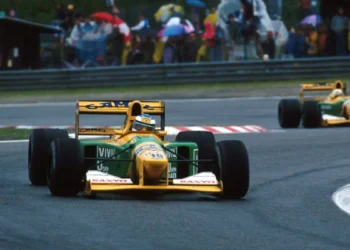Picture this: it’s race day, adrenaline is pumping, fans are roaring, and engines are ready to ignite. Then, the skies open up, and the show-stopping NASCAR action screeches to a halt. For fans and drivers alike, rain delays are the ultimate buzzkill. In the 2024 NASCAR Cup Series alone, six out of 36 races were disrupted by rain, including the iconic Daytona 500, which had to be pushed to the next day.
The idea of doming NASCAR tracks seems like the ultimate fix—a permanent solution to rain delays. But while the concept looks great on paper, the logistics and costs tell a very different story. Let’s dive into why NASCAR tracks won’t be going under domes anytime soon.
Dome Dreams vs. NASCAR Realities
The idea of covering NASCAR tracks with domes isn’t new. Fans have long speculated about its feasibility, but a recent deep dive by Joe Gibbs Racing illuminated the true scale of the challenges.
1. The Diversity of Tracks
NASCAR isn’t a one-size-fits-all sport. Its tracks vary wildly in size and design. From the 2.5-mile Daytona International Speedway to the compact 0.533-mile Bristol Motor Speedway, each track presents unique challenges for a potential dome. Building a structure large enough to accommodate tracks like Talladega (2.66 miles) would be an engineering feat of science fiction.
2. The Sound and Emissions Problem
Domes trap more than just rain—they also amplify sound and emissions. A closed dome would create a cacophony of reverberating engine roars, making the fan experience unbearable. Not to mention the buildup of exhaust fumes, which would turn the dome into a giant gas chamber unless sophisticated (and costly) ventilation systems were installed.
3. The Price Tag
Then there’s the money. Covering a half-mile track like Bristol is estimated to cost $80 million. Now scale that up to Daytona or Talladega, and the price skyrockets to the hundreds of millions. As Joe Gibbs Racing pointed out, a proposed one-mile domed track in Connecticut was pegged at $400 million—in 2004. Adjusting for inflation, that figure is easily north of $600 million today.
NASCAR’s current budget, while robust, simply doesn’t allow for such lavish spending. And with 42 tracks in the rotation, the idea of doming even a fraction of them is financially untenable.
Innovating Around the Rain: NASCAR’s Current Solutions
While domes may be out of reach, NASCAR hasn’t been sitting idly by. The sport has made significant strides in weather management, most notably with the Air Titan system.
Air Titan 2.0: NASCAR’s Track-Drying Marvel
Introduced in 2014, the Air Titan 2.0 is a game-changer in post-rain strategies. Mounted on a Toyota Tundra, this high-tech system disperses air at a staggering 585 mph, quickly drying tracks and even raising surface temperatures by up to 70 degrees.
Compared to its predecessor, the Air Titan 2.0 is faster, more fuel-efficient, and eco-friendly, reducing fuel consumption by 78% and CO2 emissions by 80%. It can slash drying time by 25-50%, depending on atmospheric conditions. Former NASCAR Chairman Brian France hailed it as a “win-win-win” for fans, the sport, and the environment.
What Air Titan Doesn’t Solve
Despite its brilliance, the Air Titan is a reactive solution—it only comes into play after the rain stops. NASCAR still lacks an answer for sudden downpours mid-race, leaving fans and teams frustrated when the skies won’t cooperate.
The Bristol Dome: A Blueprint for the Future?
If there’s one track where a dome could become reality, it’s Bristol Motor Speedway. With its smaller size and high-profile events, the feasibility and return on investment make Bristol a prime candidate for a domed trial. Joe Gibbs Racing suggests that leaving parts of the structure open for sound and emissions could make the project more practical.
A successful Bristol dome could pave the way for future domes at select tracks. However, even this remains an optimistic speculation for now.
Why NASCAR Isn’t in a Rush
The logistics, costs, and technical challenges of doming tracks make it clear why NASCAR is hesitant to pursue this idea. Instead, the organization has focused on incremental improvements like the Air Titan and experimenting with rain tires on road courses. These innovations may not eliminate rain delays entirely, but they showcase NASCAR’s commitment to enhancing the fan experience without breaking the bank.
The Future of Weather-Proof Racing
While domed tracks remain a distant dream, NASCAR’s continued innovation leaves room for optimism. From advanced track-drying systems to ongoing discussions about rain tires, the sport is actively working to mitigate weather disruptions.
For now, fans will need to accept the occasional rain delay as part of the NASCAR experience. But who knows? With Bristol potentially leading the way, the day may come when domes over tracks are no longer a fantasy but a game-changing reality. Until then, we’ll have to keep our fingers crossed for clear skies and trust in NASCAR’s ever-evolving ingenuity.









